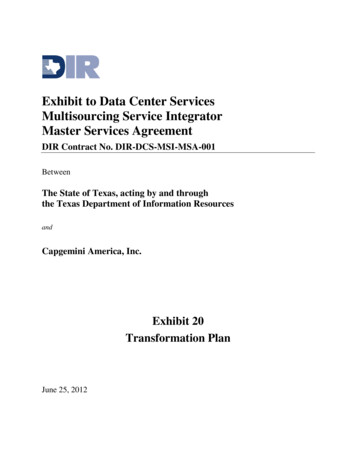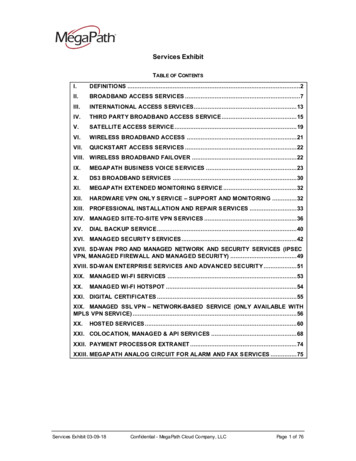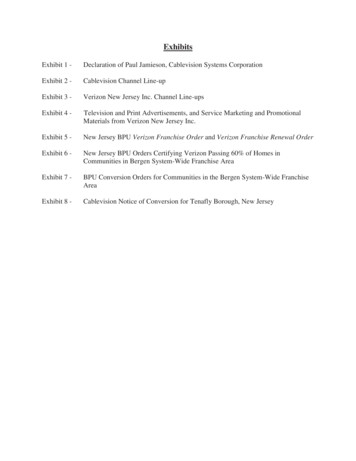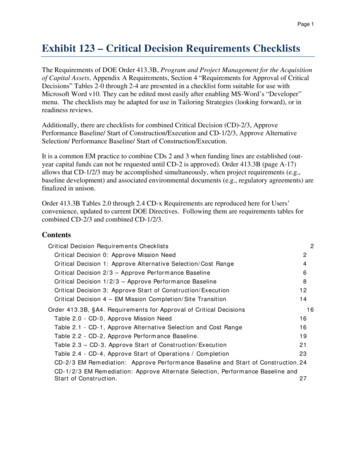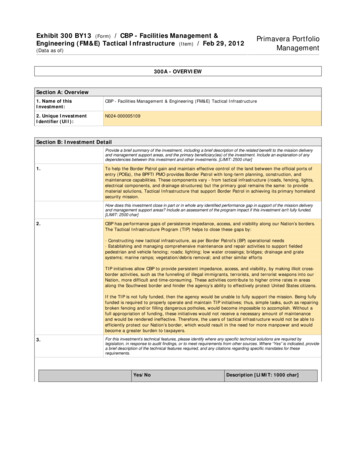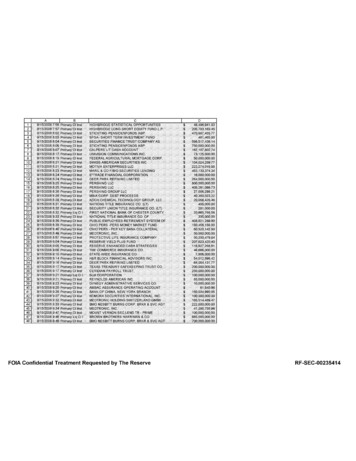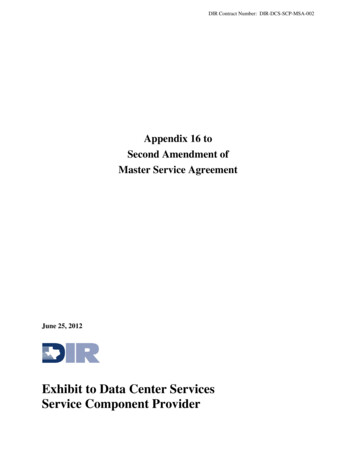
Transcription
DIR Contract Number: DIR-DCS-SCP-MSA-002Appendix 16 toSecond Amendment ofMaster Service AgreementJune 25, 2012Exhibit to Data Center ServicesService Component Provider
DIR Contract No. DIR-DCS-SCP-MSA-002Master Services AgreementDIR Contract No. DIR-DCS-SCP-MSA-002BetweenThe State of Texas, acting by and throughthe Texas Department of Information ResourcesandXerox State and Local Solutions, Inc.Exhibit 20Transformation PlanJune 25, 2012Exhibit 20 Transformation PlanPage 2 of 30
DIR Contract No. DIR-DCS-SCP-MSA-002TABLE OF CONTENTSEXHIBIT 20 TRANSFORMATION PLAN . 5UPDATE METHODOLOGIES AND ATTACHMENTS TO EXHIBIT 20 . 5THE FOLLOWING UPDATE METHODOLOGIES AND ATTACHMENTS AREINCORPORATED AS PART OF EXHIBIT 20: . 51.TRANSFORMATION MANAGEMENT. 61.1Introduction . 61.2Document Overview. 62.TRANSFORMATION GUIDING PRINCIPLES. 63.TRANSFORMATION OBJECTIVES . 74.TRANSFORMATION APPROACH AND PROJECT METHODOLOGY . 84.1Transformation Program . 84.1.1 Annual Transformation Plan . 105.STABILIZATION OVERVIEW . 105.1Stabilization Staffing . 115.2Stabilization Coordination and Integration . 115.2.1 Cross-Functional Services Stabilization . 115.3Stabilization by Service Component . 155.3.1 Mainframe Service Component Stabilization . 155.3.2 Server Service Component Stabilization . 165.3.3 Data Center Service Component Stabilization . 175.3.4 Network Service Component Stabilization . 196.CONSOLIDATION OVERVIEW. 226.1Consolidation Staffing . 226.2Consolidation Coordination and Integration . 226.3Consolidation by Service Component. 226.3.1 Mainframe Service Component Consolidation . 226.3.2 Server Service Component Consolidation . 226.3.3 Data Center Service Component Consolidation . 266.3.4 Network Service Component Consolidation. 267.OPTIMIZATION OVERVIEW . 268.SERVICE PROVIDER TRANSFORMATION ROLES AND GOVERNANCE ALIGNMENT279.QUALITY CONTROL AND GENERAL RISK MITIGATION . 2810.COMMUNICATIONS. 29Exhibit 20 Transformation PlanPage 3 of 30
DIR Contract No. DIR-DCS-SCP-MSA-00210.1Stabilization Communications . 2910.2Consolidation Communications . 2910.3Transformation Program Communications . 30Exhibit 20 Transformation PlanPage 4 of 30
DIR Contract No. DIR-DCS-SCP-MSA-002EXHIBIT 20TRANSFORMATION PLANUpdate Methodologies and Attachments to Exhibit 20The following update methodologies and attachments are incorporated as part of Exhibit 20:TitleExhibit 20Transformation PlanAttachment 20-ATransformationMilestonesExhibit 20 Transformation PlanMethodology for Updating Associated Exhibit AttachmentsExhibit 20 is updated in accordance with Section 4.3(b) of theMSA.Attachment 20-A may only be modified by formal amendment,in accordance with Section 21.7 of the MSA.Page 5 of 30
DIR Contract No. DIR-DCS-SCP-MSA-0021.TRANSFORMATION MANAGEMENT1.1IntroductionIn accordance with Section 4.3 of the Agreement, this Exhibit 20 and the attachedAttachment 20-A collectively constitute the Transformation Plan, and references to theTransformation Plan in this Agreement (including this Exhibit) shall be read andunderstood to collectively mean this Exhibit 20 and the attached Attachment 20-A.Service Provider shall maintain and implement the Transformation Plan, and anymodifications to the Transformation Plan shall be subject to DIR’s review and approvalin accordance with Section 4.3 of the Agreement. The provisions of the TransformationPlan are in addition to, and not in lieu of, the terms and conditions contained in the bodyof the Agreement and the other Exhibits and Attachments thereto; provided however,unless otherwise expressly stated, the provisions of this Transformation Plan shall notcontrol over conflicting provisions of the Agreement. Unless otherwise expresslydefined in the Transformation Plan, capitalized terms used in the Transformation Planshall have the meaning assigned to them elsewhere in the Agreement.The dates in this document are intended to provide context and set expectations for thesolutions described. Actual milestone dates are contained in the appropriate milestonedocuments (Attachment 19-A Transition Milestones and Attachment 20-ATransformation Milestones). In the event of a conflict in dates the dates in themilestone documents will control.1.2Document OverviewTransformation consists of activities necessary to evolve from DIR’s existingenvironment (via changes to the infrastructure, processes, tools, etc.) to meet theobjectives of the State.Transformation consists of stabilization, optimization, and consolidation.2.TRANSFORMATION GUIDING PRINCIPLESThe Service Provider will:Provide a customized approach to meet the needs of DIR which includes: DIR and DIR Customer transformation modelsExperienced transformation project managersLeveraging Service Provider's tools and templates customized to the DIRand DIR Customer environmentsEstablish strong governance, which includes: Clearly defined roles and responsibilitiesJointly developed processesExhibit 20 Transformation PlanPage 6 of 30
DIR Contract No. DIR-DCS-SCP-MSA-002 Effective meetings and reporting framework to minimize resourcerequirements while achieving goalsMechanisms in place to identify and address risks and issues earlySupport for OLA developmentMaintain effective communication, which includes: Consistent delivery of key messages through well-defined communicationplansTailored communications to target audiences and stakeholdersMutually agreed frequency of communications to meet the needs of thestakeholdersPromote collaboration and teamwork , which includes: 3.Detailed upfront project planning and feedbackJoint agreement on status for reporting purposesPlans scaled to address DIR Customer differences in size and complexityEstablishment and support for successful deliverable review processFeedback on deliverables throughout the life of the project.TRANSFORMATION OBJECTIVESTransformation includes Server, Network, Data Center and Mainframe Services. There will be3 phases of Transformation.1. Stabilization –includes remediating the environment by closing out the problem, requestand solution backlogs, addressing Servers needing immediate refresh, andimplementing a new backup and recovery solution. Consolidation – will focus onvirtualizing, migrating or refreshing Servers into the Consolidated Data Centers. Theconsolidation will be complete at Commencement forty-eight (48) months.2. Optimization – will be on-going improvements to the environment that will benefit theState by reducing costs, improving services or both.The Transformation program will be managed to ensure:1. Transformation Milestones (Attachment 20-A) are completed on-time.2. Acceptance criteria defined and agreed to for each Milestone Deliverable inAttachment 20-A will be met3. Disruption to DIR Customers’ business is minimizedExhibit 20 Transformation PlanPage 7 of 30
DIR Contract No. DIR-DCS-SCP-MSA-0024.TRANSFORMATION APPROACH AND PROJECTMETHODOLOGYThe Service Provider will utilize the MSI’s project management methodology and toolset. TheService Provider will work with the MSI to infuse the methodology with the Service Provider’sbest practices and standard templates tailored to meet specific requirements of DIR and DIRCustomers.Transformation Program4.1The Service Provider will be DIR and the MSI’s partner in the Transformation process. TheService Provider will use dedicated project managers, consistent communication, and a projectmanagement structure.The Service Provider will plan the Transformation with participation from DIR, the MSI andDIR Customers. Service Provider will deliver Phase I of the Transformation Plan one hundred andtwenty (120) days after the Execution Date. Service Provider will deliver Phase II, including DIR Customer-specificTransformation plans one hundred and twenty (120) days after Commencement Date.The Transformation Plan will be organized into three (3) phases – stabilization, consolidationand optimization. Figures 1 and 2 below show the overall timeline for the consolidation andstabilization phases of Transformation. The timeline below is for illustrative purposes and alldates follow the Agreement.Exhibit 20 Transformation PlanPage 8 of 30
DIR Contract No. 2Q3Backlog StabilizationCross Functional StabilizationServer, Network,Mainframe andData CenterTriage Stabilization (Refresh)Q4Q5Q6Q7Q8Y3Y4Y5 Address current backlog – bring to zero Service Problem Back-up and Recovery TRGs Run Books Address 600 high riskservers Refresh S/W Upgrades &patchesTower StabilizationCommencement Date Network Assessmentand PlanNetwork ReplacementData Center – ADC &SDC Mainframe – toolsTransformation EndFigure 1. Stabilization Phase TimelineExhibit 20 Transformation PlanPage 9 of 30
DIR Contract No. DIR-DCS-SCP-MSA-002-Q2ConsolidationWork GroupManagement-Q1Q1Q2Q3Q4Q5Q6Q7Q8Y3Y4Transf ormation Setup & Management OversightTFM PlanningData Center Inf rastructure Setup to support ConsolidationServer ConsolidationServerNetwork Support f or Server consolidationNetworkMF Processor UpgradeMainframeEffective DateCommencement DateTransformation EndFigure 2. Consolidation Phase Timeline4.1.1Annual Transformation PlanThe Service Provider will update the Transformation Plan each year, in accordance withExhibit 3. The Service Provider will start with the master schedule to control ongoingTransformation activities and add more detail to describe Transformation activities for thecoming year. Updates to the Transformation Plan may also occur any time throughout the year.5.STABILIZATION OVERVIEWStabilization begins as part of Transition, with a dedicated team visiting all DIR Facilities,completing a wall-to-wall inventory and updating the configuration management database(CMDB). During stabilization, as a first phase of Transformation, this team also will providefor remote monitoring, reliable data backup and recovery, and will identify at risk Servers,targeting them for prioritized refresh by a separate, dedicated triage team. A third team will bededicated to processing the backlog of service requests during this phase.As part of this set of activities, the Service Provider also will begin the Application portfolioinventory, including incorporating that data in the CMDB for use in later analysis and planning.Recognizing that Application migration/remediation represents a critical prerequisite for theoverall Server consolidation project, the Service Provider has included an applicationsenterprise architect as part of the Service Provider chief technology officer organization. Thisarchitect will collaborate with the Transition and Transformation teams, as well as withindividual DIR Customers, to help with the assessment, planning, and execution of migrationand remediation efforts.Exhibit 20 Transformation PlanPage 10 of 30
DIR Contract No. DIR-DCS-SCP-MSA-002Stabilization Staffing5.1The cross functional stabilization team will utilize resources from the transition team toperform discovery, complete the asset inventory, load the CMDB and create the appropriatesections of the Service Management Manual. The backlog and triage teams will be dedicated tocompleting the problem and service backlogs that exist at Commencement. In addition, each ofthe services will have teams dedicated to completing the stabilization efforts specific to thoseservices. These teams will all work closely with the MSI, DIR and DIR Customers to completethe stabilization effort.Stabilization Coordination and Integration5.25.2.1 Cross-Functional Services StabilizationThe Cross functional stabilization program consists of the following: Backup and RecoveryProblem ManagementConfiguration ManagementService Request Management andBacklog IT Service ContinuityProject ManagementChargeback ManagementBackup and RecoveryThe Service Provider will provide the new backup environment for the Servers in theConsolidated Data Centers, Legacy Data Centers and Business Offices by Commencement three (3) months. The migration plan for implementation will be provided. The ServiceProvider will implement Symantec Ops Center toolset. The NetBackup agent will be installedon each Server to be backed up and the backup information will be transferred over the networkeach evening to the centralized infrastructure in the ADC. There may be a few exceptionswhere the agents cannot be installed on the Servers or there is a network capacity issue thatcannot be resolved. In these cases, the Incumbent Service Provider’s backup method will beretained and utilized until the Server is refreshed or consolidated.The backup and recovery team will focus on three main activities. The first activity includes gathering information as part of knowledge transfer. TheService Provider team will gather the backup reports and configurations to understandthe environment including problem areas such as backups not occurring or incomplete.The Service Provider will also pull DIR Customer’s requirements from the schedules,retention periods and target directories documents on the Portal. The Service Providerwill utilize these backup configurations/rules in the new backup solution.Exhibit 20 Transformation PlanPage 11 of 30
DIR Contract No. DIR-DCS-SCP-MSA-002 The second activity includes installing the Symantec OpsCenter Net Backup agents onindividual Servers at Business Offices, in the Legacy Data Centers and the ConsolidatedData Centers. The Service Provider will also implement media Servers at sites withmore than 10 Servers or other sites where the network capacity cannot handle thevolume of backup data. This activity will be completed by the team installing the rest ofthe tools during Transition. The third activity includes the implementation of the backup core infrastructure in theADC and implementation of the new backup methods at all sites. In addition, theService Provider will update and/or create the backup monitoring, reporting and issueresolution procedures. The backup solution will be completed by Commencement fifteen (15) months.Problem ManagementThe Service Provider Problem Management team, a dedicated team separate from steady state,will work with the MSI to define the Problem Management process, train the Service Providersteady state team on the process and implement the process. In addition, the Service Providerand the MSI will have a team focused on closing out the backlog of Problem tickets that exist atCommencement. The MSI will rationalize and categorize the tickets and work with the DIRCustomers to prioritize the tickets. The Service Provider will then create a plan to address thetickets and work the tickets to completion. The plan will be completed by Commencement one and a half (1.5) months and the backlog of tickets will be completed by Commencement twelve (12) months. There may be some aged Problem tickets where it is no longer possible togather information for an RCA. In these cases, the MSI will work with the affected DIRCustomer to ensure they agree with closing the problem ticket and the ticket will be closedwithout an RCA. Where the Root Cause can be identified, the Service Provider and MSIProblem Management team will determine whether to incorporate the solution into theTransformation work already planned or implement the solution as a separate initiative. TheMSI will work with the affected DIR Customers to gain agreement on the approach forresolution.Configuration ManagementThe configuration management team, separate from steady state, has five (5) sub-teams. The first sub-team which is part of the Service Provider Transition team will perform awall to wall inventory before Commencement. This team will utilize the existingCMDB during the wall-to-wall inventory to verify information and fill in any gaps inthe existing CMDB. The second sub-team, which is also part of the Service Provider Transition team, willimplement the Service Provider’s auto-discovery tool – ADDM. This team willimplement the ADDM appliance within each DIR Customer’s network beforeCommencement. The appliance must run for at least a month to capture all assets andExhibit 20 Transformation PlanPage 12 of 30
DIR Contract No. DIR-DCS-SCP-MSA-002asset interdependencies. The appliance will continue to run after Transition andTransformation. The Service Provider Transition team will reconcile this informationwith the wall-to-wall inventory information and existing CMDB beforeCommencement. On the third-sub-team, the Service Provider architects will utilize the ADDMinformation to begin work on the System Engineering Management Plan (SEMP). TheService Provider uses the SEMP as a template to gather additional information abouteach of the Applications before Commencement. After all the information is gathered and loaded into the CMDB, the fourth sub-team,also part of the Transition team, will work with the MSI to complete the true up whichis due four (4) months after Commencement. The Service Provider’s fifth sub-team will work with the MSI to define CMDB updateprocesses by Commencement. By this time, the steady s
services. These teams will all work closely with the MSI, DIR and DIR Customers to complete the stabilization effort. 5.2 Stabilization Coordination and Integration 5.2.1 Cross-Functional Services Stabilization The Cross functional stabilization program consists of the following: Backup
